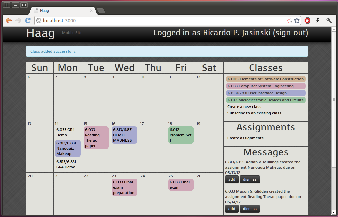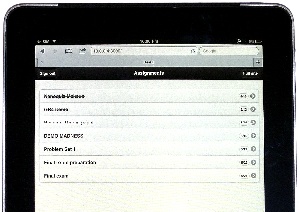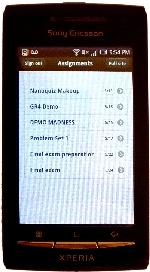GR6 – User testing
Table of Contents

Design
Our final design uses the metaphor of a calendar. The main view is divided into 2 regions:
- A large calendar, with a span of 4 weeks (previous, current, and next two weeks).
- A sidebar with links to the available actions and information that must be reviewed by the user. The sidebar is further divided into 3 sections:
- A list of subscribed classes. The list double-duties as a legend for the color coding used for the assignments;
- A list actions available for working with assignments;
- A feed with messages generated by the system that must be reviewed by the user.
The screenshot below shows the main view of the application:

The most common tasks are adding an assignment and crossing an assignent off the calendar. To provide for better efficiency, there are multiple of adding an assignment:
- Click on a blank region on the calendar, to add an assignment for a specific date
- Click on a class same on the sidebar, to add an assignment for that specific class
- Click the self-descriptive sidebar link
Because the assignments are shown directly on the calendar, a user can mark as assignment as complete in the simplet possible way: just click on the assignment, and it gets crossed off the list. This action is revertible: clicking a completed assignment reverts it to the "due" state.
Haag features a mobile interface that is loaded automatically when a user logs in from a smartphone or tablet device.
 |
 |
Mobile interface on an iPad |
Mobile inteface on an Android phone |
Changes made after Paper Prototyping
During paper prototyping, we identified that the mobile phone screen would probably be too small to implement a calendar view as rich as the one shown on the desktop. Therefore, we decided to implement the assignments view as a list, keeping it simple, readable, and easy to interact with. The screenshots above demonstrates how assignments are show on the mobile interface.
Changes made after Heuristic Evaluation
- Improved consistency accross dialogs: based on a somewhat misguided guideline, we had implemented some actions of our dialogs using hyperlinks (e.g., 'Cancel'), and uthers using buttons (e.g., 'Save'). Our users complained, and we got rid of the links and adopted buttons for all dialog actions.
- Combined similar actions: our users complained that the interface had similar actions (e.g., 'Create assignment' vs. 'Create multiple assignments') and that added some confusion, so we unified them ('Add asignments').
- Use attribute names consistent with the real world: in Rails, it is common to name timestamp attributes ending with the suffix '_at". This surfaced to the interface and the evalulators requsted it to be changed to 'Due at'. A similar problem happened with our implementation of a 'Class' object; because 'class' is a reserved word in Ruby, we named our structure 'Course', and it surfaced to the UI.
- Added information about Haag on the login screen: some evaluators were concerned that it was not possible to know what the application does, so we added a short explanation on the landing page.
- Implemented missing features: we implemented the missing features from GR4, most of which were picked by the evaluators: allow unsibscribing from a class; implement undo for marking assignment as completed; allow creating private assignments.
Implementation
Our application was implemented using the Rails framework (version 3.1.3). For effects and widgets, we used the jQuery UI libraryon the desktop version, and jQuery Mobile on the mobile version.
Rails applications are structured according to a model-view-controller (MVC) pattern, and are expected to adhere to a series of guidelines. This "convention over configuration" philosophy benefits the designer by ensuring that if the guidelines are followed the low-level details of the application will be handled automatically. This allowed us to have the first features running in a short time.
These two characteristics (MVC arquitecture and convention over configuration) greatly contributed to the implementation of the mobile version. In Rails, by registering a mime type 'mobile' and naming the views accordingly (e.g., 'edit.mobile.erb'), the framework will render the corresponding view when the application is accessed from a mobile device. This enabled the mobile version to be implemented with the addition of only 120 lines of code (7% of the application total).
Evaluation
We found three undergraduates for the user tests. One has a calendar with all of her assignments for the entire year, one makes a list for each upcoming week, and one just keeps everything in his head. We managed to test someone who matched each of our original user scenarios.
To start the test, we opened up the homepage and gave this briefing:
This is HAAG, a collaborative calendar. If one student creates a calendar for her class, other students can subscribe to the feed. The entire class can have an up-to-date list of assignments, without everyone having extraneous duplicate work.
We gave each user 7 tasks:
- Sign up for an account
- even though the sign up button was not on the homepage, all users rapidly found it
- 2/3 users entered a password that was too short, and had to go through the form a second time
- Go add 18.03 to your calendar. The assignments are: PS1 on the 11th and PS2 on the 16th.
- No users had trouble creating the class
- 2 people entered "18.03", one put in a more descriptive name
- 2/3 users entered assignments by clicking on days in the calendar, the third used the "new assignment" button on the right
- 1 user was impatient and clicked the submit button twice. This resulted in two new assignments on the page.
- Your 6.033 TA told you that he created a feed for all of the 6.033 assignments. Find and add his feed.
- 1 user has a moments hesitation before finding which link to
- The other two found the link quickly and had no trouble at all
- You finished PS1 for 6.813 – go and mark it as completed.
- No users had trouble with this step
- One user remarked that she really liked the quick animation between active and completed
- You later remember that you weren't actually finished with PS1 – mark it as unfinished
- There was slight hesitation after saying this – probably because it's not a common action, and it took a moment to parse
- All users did this without further prompting
- You decide to add a personal assignment, "Reading: Learning Java," to 6.813. Go add it to your schedule for the 13th.
- Everyone created the assignment correctly, and removed the "shared" checkbox
- One user searched for that box before entering the name of the assignment
- Users entered this task with a goal. If they didn't know this feature existed, it may have taken longer
- Later, when away from your computer, you finish the Java reading. Go on your phone and mark it as completed. (we switched users to the mobile version for this question)
- While users didn't have trouble with this task, it took them a moment to scroll through all the tasks and find the correct one
- Sometimes there were multiple assignments with the name name (i.e. "Reading")
The usability tests brought forth a few minor issues:
- (Minor) There was a small bug where we didn't have the correct information in the header bar (i.e. a section was blank)
- We already fixed this with a quick patch
- (Major) Users were much slower on the mobile version. This is a concern especially beacuse the primary goals of the mobile interface should be convenience and efficiency.
- We should label assignments with color & name of the class
- Really old assignments could be moved to the bottom of the list to show more recent ones
- (Minor) "Shared" may be confusing without the prompting of the usability test
- We could replace the "Shared" checkbox with a radio button between "Private" and "Public"
- (Cosmetic) The colors chosen are sometimes too similar
- One approach would be to allow users to choose their own colors
- We could also create a more sophisticated algorithm for choosing distinct colors
Reflection

